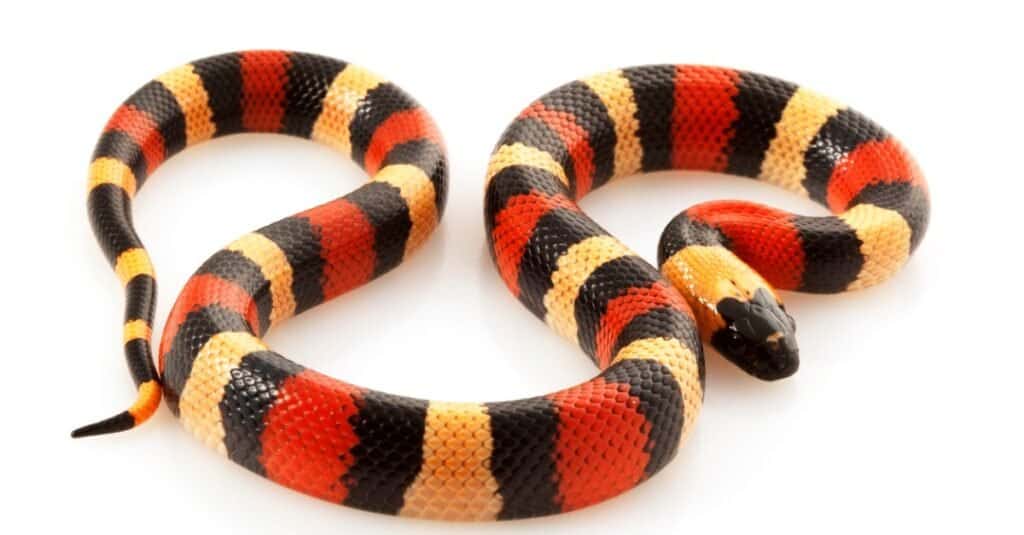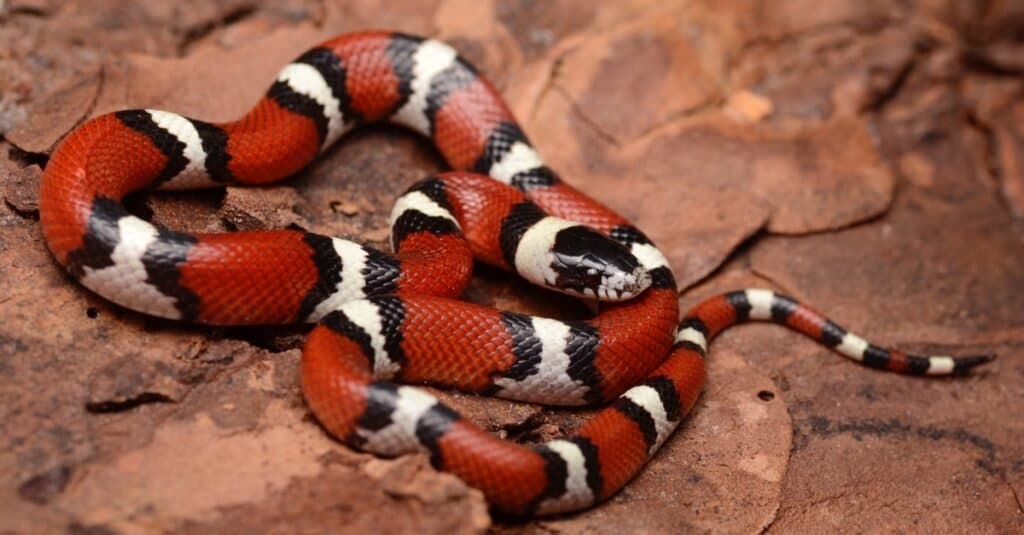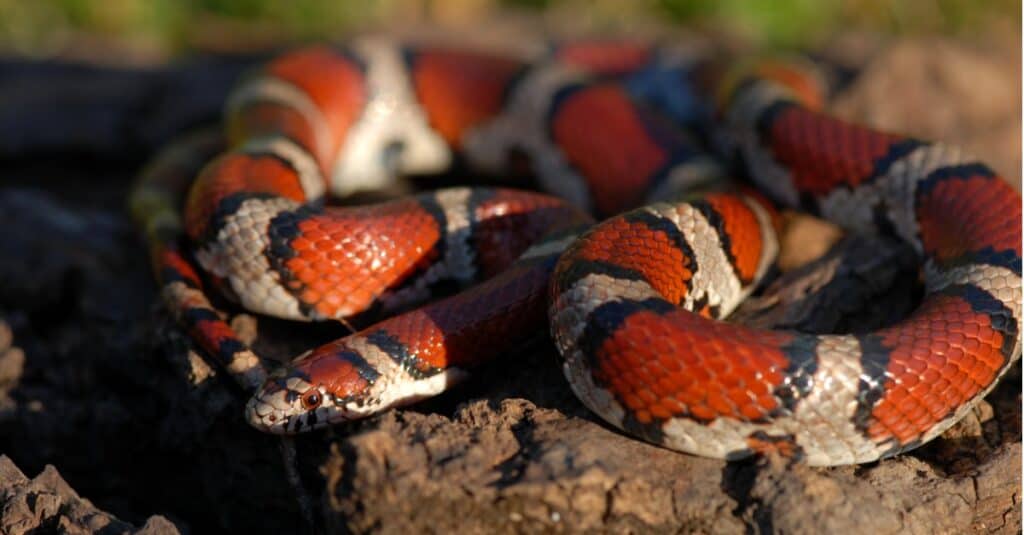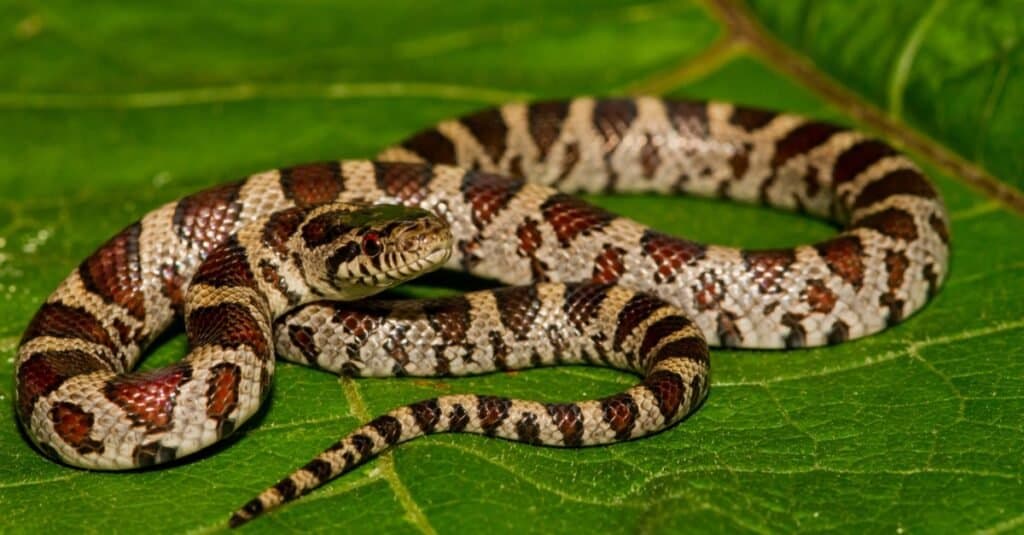Key Points
- Milk snakes have smooth, shiny scales with various patterns of red, black, and yellow or white.
- There is a ton of variation when it comes to the appearance of these types of snakes.
- Milk snakes look like coral snakes. It keeps them safe from other animals but milk snakes are often killed or harmed by humans who mistake them for venomous snakes.
Milk snakes are beautiful and brightly colored, with a look that is both exotic and dangerous. However, these snakes are not dangerous at all. In fact, they are nonvenomous and harmless to humans. Milk snakes are a species of kingsnake that live in Canada, the United States, and Central and South America.
These snakes generally have banded or blotched patterns in some variation of red, black, and yellow, or white. There are 24 subspecies of milk snakes, and each has its own unique variation. Milk snakes also come in a wide range of different lengths and sizes.
But, just how big is the largest milk snake ever recorded?
Keep reading to find out!
What Do Milk Snakes Look Like?

Milk snakes have a similar appearance to coral snakes
©iStock.com/amwu
Milk snakes have smooth, shiny scales with various patterns of red, black, and yellow or white. Many milk snakes have rings or crossbands, but a few species have blotches on their bodies instead. The colors and patterns of milk snakes make them look like the dangerous coral snake.
However, milk snakes are nonvenomous and harmless. Their colors and patterns are a form of Batesian mimicry. This is when a harmless animal mimics the appearance of a dangerous animal in order to frighten potential predators.
Unfortunately, although looking like a coral snake keeps them safe from other animals, milk snakes are often killed or harmed by humans who mistake them for dangerous, venomous snakes. In addition, many species of baby and juvenile milk snakes have bodies that are primarily red or have a reddish color. Humans often kill them because this reddish color makes them look similar to venomous copperhead snakes.
There is a lot of variation when it comes to the appearance of a milk snake. For example, the Eastern milk snake has a cream or beige-colored body and red or reddish-brown blotches with black outlines. On the other hand, the Honduran milk snake has a bright red body, with black and yellow rings or crossbands. Some Honduran milk snakes may even have orange bands instead of yellow.
What is the Largest Milk Snake Ever Recorded?

Milk snakes in the United States only grow to around 51 inches long.
©TheTexasNaturalist/Shutterstock.com
The 24 different types of milk snakes also have very wide range when it comes to size. Depending on the snake and species, a milk snake could be anywhere from only 14 inches long to 69 inches long!
For example, the New Mexico milk snake typically grows between 14-24 inches in length, while Honduran milk snakes measure between 36-48 inches long.
But what is the largest milk snake ever recorded? That title goes to the black milk snake. Black milk snakes typically grow between 3-6 feet, but the largest snake ever recorded was 7 feet long!
Black Milk Snakes: The Largest Milk Snakes Ever Recorded

The black milk snake is the largest species of milk snake ever recorded, growing up to 7 feet long! These snakes are also quite hefty, weighing between 3 – 3 ½ pounds. Black milk snakes are native to Panama and Costa Rica, where they live in wet, high mountain forests.
When black milk snakes first hatch, they can be as large as 12-16 inches long and are already big enough to easily eat small mice. As adults, black milk snakes are typically very hardy and can eat almost anything from mice and small mammals to reptiles, invertebrates, amphibians, birds, and eggs.
One of the most unique characteristics of the black milk snake, in addition to its large and beefy body, is that this snake actually changes color! Black milk snakes are black, red, and white or yellow when they are born, just like many other types of milk snakes.
As they get older, however, they begin to change color. When they are around 6-10 months old, black milk snakes begin transitioning into their namesake, iconic black coloring. No one really knows why these snakes do this.
However, one of the main theories is that because black milk snakes live in the cold at high altitudes in the mountains, their black bodies help them to heat up quickly and then retain that heat.
Where Do Milk Snakes Live?

The Pueblan milk snake lives in Mexico. Milk snakes in Central and South America are typically bigger than those living in the United States.
©iStock.com/David Kenny
Milk snakes live in North, Central, and South America. Their preferred habitat varies greatly, depending on the species of milk snake. However, they commonly live in forested areas, as well as on rocky slopes, swamps, farmland, prairies, and along beaches and sand dunes. Some species of milk snake also migrate depending on the season, spending summers and winters in different habitats.
Milk snakes brumate from October or November until the middle of April. Brumation is very similar to hibernation, except that these snakes do not go into a deep sleep for the entire winter. Instead, milk snakes go into an energy-saving mode, where they sleep most of the time, but wake up to drink water.
Are Milk Snakes Dangerous?

The common name “milk snake” originated from the false belief that these snakes milked cows.
©iStock.com/Shoemcfly
Although they may look like venomous coral snakes, milk snakes are not dangerous at all! Many people use a poem to help them remember the difference between coral snakes and milk snakes. For example, “Red on yellow, kills a fellow; red on black, is a friend of Jack”. This works well for most snakes in the United States.
Milk snakes in the U.S. have red bands next to black bands (“red on black”), while coral snakes have red bands next to yellow bands “red on yellow”). However, this saying does not always work for snakes outside of the United States. If you are unsure if a snake is venomous or not, the best thing to do is to give it a wide berth and leave the snake alone.
No matter the pattern, all 24 types of milk snakes are not venomous and are completely harmless to humans. These snakes are generally nocturnal, secretive, and move slowly. When threatened, a milk snake’s first choice is to flee. If it is cornered, however, a milk snake may vibrate its tail and strike at the threat quickly and repeatedly.
These snakes have tiny teeth and are not venomous, so a bite will not do a great deal of harm. In general, most milk snakes are relatively docile, and some people even keep them as pets.
What Do Milk Snakes Eat?

Eastern milk snakes are very beneficial animals, especially for farmers, as they hunt down small rodents often found on farm buildings and barns.
©Jay Ondreicka/Shutterstock.com
Milk snakes get their name from an old urban legend that they drink the milk from cow utters. This is completely untrue, not to mention it is physically impossible.
The myth most likely originated because milk snakes are commonly found in barns or near farmland. Milk snakes enjoy these areas because they provide sheltered space for resting during the day, and because there are often many rodents nearby that provide a quick and easy meal.
In addition to rodents, milk snakes eat a wide variety of other animals as well. These snakes are opportunistic hunters, and eat small mammals, birds, frogs, snakes, fish, eggs, and lizards. Many milk snakes are particularly fond of skinks.
Some milk snakes have even been known to go after their venomous look-a-like, the coral snake! Baby and juvenile milk snakes eat young mice, insects, earthworms, slugs, and sometimes lizards.
Milk Snakes as Pets

In captivity, milk snakes can live up to 20 years.
©Siarhei Kasilau/Shutterstock.com
Because of their vivid colors and generally hardy nature, milk snakes are becoming increasingly popular as pets. The most common pet milk snakes are the Honduran milk snake and the Eastern milk snake.
The Honduran milk snake is native to Costa Rica, but today most pet snakes are bred in captivity. This snake acclimates and adapts fairly well and is considered a good snake for beginners.
The Eastern milk snake, on the other hand, requires a more experienced pet owner. These snakes have a harder time adapting and acclimating to a new home, and they can be pretty touchy. When they feel threatened, eastern milk snakes flatten their heads and repeatedly strike until the threat goes away.
Other Record-Breaking Snakes
While some snakes like the milk snake have markings that help them look like venomous snakes in order to confuse predators, other snakes have amazing abilities. One such example is the flying snake, which is capable of gliding through the air from tree to tree or even across the ground in order to capture prey. Now that you know how big the largest milk snake is on Earth, let’s also take a look at the size of flying snakes. Just how big is the largest flying snake in the world?
There are 5 species of flying snakes that inhabit Sri Lanka, south China, India, southeastern Asia, and the Greater and Lesser Sunda Islands. All of the species live among tree branches and leaves, hunting for lizards, frogs, and other small animals as prey. One particular species, the golden tree snake (also ornate flying snake), is the largest type, able to grow up to 4 feet long. Golden tree snakes also have thicker bodies, but this limits how far they can glide in the air compared to other flying snakes. To learn more about flying tree snakes, including more details on golden tree snakes, check out the article below.
The photo featured at the top of this post is © reptiles4all/Shutterstock.com
Discover the "Monster" Snake 5X Bigger than an Anaconda
Every day A-Z Animals sends out some of the most incredible facts in the world from our free newsletter. Want to discover the 10 most beautiful snakes in the world, a "snake island" where you're never more than 3 feet from danger, or a "monster" snake 5X larger than an anaconda? Then sign up right now and you'll start receiving our daily newsletter absolutely free.
Thank you for reading! Have some feedback for us? Contact the AZ Animals editorial team.






